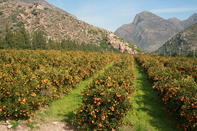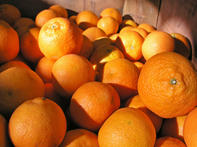A wide range of soft citrus varieties is planted in South Africa. This can roughly be divided into three groups: mandarins, clementines, and satsumas. The choice of variety is determined by market demand and the suitability of the variety to the production conditions on a farm.

Mandarin Oranges
Mandarins and tangerines are technically the same fruit. The difference in name lies in the place the fruit was thought to have originated from. Mandarins refer to soft citrus thought to have developed in southwest China, whereas tangerines are thought to have developed in Tangiers, a city in Morocco.
Mandarins, however, are believed to have descended from wild oranges that grew in northeast India more than 3 000 years ago. From there the citrus made its way to China, and from there to Europe and North Africa.
In 2017, mandarins were the most planted soft citrus, it accounted for nearly 75% of the total area under production. While a large range of mandarin varieties is planted, Nardorcott was the most widely planted, at roughly 37% of all the plantings. Nova accounted for 19% and Tango represented about 12% of the total area under production.
Nardocott developed more than forty years ago out of Murcott seedlings at an experimental station in Morocco. The growers realised that the seedlings had lost their seeded character when they were not pollinated. This variety is in high demand because it is virtually seedless, with an outstanding eating quality and high sugars combined with intense flavour.
The variety is under plant breeders rights, with the Nardorcott Protection Company in Morocco managing cultivar rights in the Northern Hemisphere and Citrogold in South Africa managing it in the Southern Hemisphere. The best South African Nardorcott fruit is sold under the ClemenGold® brand. The fruit is harvested from mid-June to mid-August.
Nova is a hybrid that developed out of clementine mandarin and olando tangelo. It is moderately seedy to seedless and harvested from May to June.
Clementines

Clementines are thought to have developed out of an accidental hybrid composed of mandarin seedlings. Initially, it was thought that the mutation was discovered by a French missionary, Clément Rodier, in a garden of an orphanage in Algeria. But another theory took hold later, that the citrus has of oriental origins, as it is almost identical to Canton mandarin grown across China.
In 2017, clementine represented roughly 17% of the total area planted under soft citrus in South Africa. Many different varieties are planted, but production is dominated by Nules, which accounted for over 73% of the total area under production. The variety was discovered in 1953 near the town of Nules in Spain. The fruit is harvested from April to June.
Esbal, which was the second most popular variety, accounted for 7% of the plantings.
Satsumas
Satsumas bear small to medium-sized fruit that are shaped like a flattened sphere. They are sometimes slightly necked, hardly have any seeds and have segments that are easy to separate. In South Africa, they are also known as naartjies.
Satsumas are thought to have originated in China, but take their name from a place in South West of Japan, where they were first reported 700 years ago.
In 2017, satsumas accounted for roughly 9% of the total area under soft citrus. While a range of varieties is planted, the most widely planted variety was Miho Wase. This early maturing variety accounted for over 75% of the total area under production in 2017. The variety, which was registered in the 1960s, was developed in Japan from the Miyagawa Wase satsuma. The variety was never as big a commercial success in Japan as it is in South Africa.
 Soft citrus refers to a subdivision of citrus that has relatively loose skin and is easy to peel. Mandarins, clementines, satsumas, mineolas...
Soft citrus refers to a subdivision of citrus that has relatively loose skin and is easy to peel. Mandarins, clementines, satsumas, mineolas...